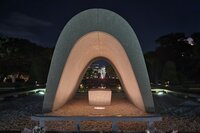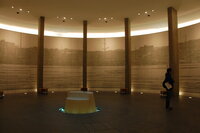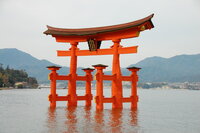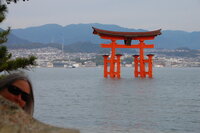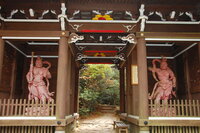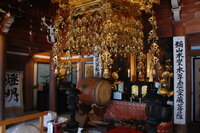Insert standard boilerplate about Shinkansen being irritatingly punctual, extremely fast, fantastically comfortable and just, well, how trains aught to be done.
Hiroshima
Whilst the trip from Takamatsu to Hiroshima was rapid and uneventful, our ability to find our way
out of Hiroshima Station was anything but. The station is absolutely in bits. It has a massive
amount of work going on, to the extent that you have to navigate around and through scaffolding in
an attempt to find a way out. There's hazard tape everywhere, exits are taped up and the signs
appear to be completely random. This would be difficult under normal circumstances, but it was
completely unexpected here in Japan and we are Steve is getting a little tired and
fractious. Under normal circumstances, we'd describe the whole place as "like a bomb
site", but perhaps that's not entirely appropriate. ¯\_(ツ)_/¯
Everyone has heard of Hiroshima and has a fair idea of why it is famous, so there's little point in labouring that. Steve had kind of thought in passing that the place would be all shiny and new looking as a result of the enforced rebuild, but the application of a little more intelligent thought reveals that it was 80 years ago so, really, the city looks pretty much like any other in Japan. The place does seem to have an edgy and trendy feel to it (which we know all about of course), especially in the evenings. So much so that on our first day we saw someone start to cross the road before the green man was fully illuminated. The horror! Actually, in reality, what comes over most is that the locals don't really seem to give a damn for the outside world or anyone else and are not as polite or even as pleasant as the people we have met elsewhere. Perhaps being bombed into oblivion does that to a society and it's hard to hold it against them. However, the place is also famous for oysters and they absolutely should be taken to task for that!

Of course, we visited the Genbaku Dome (Genbaku is Japanese for Atomic Bomb). This building was originally the Hiroshima Prefectural Industrial Promotion Hall (we don't know what that is either). It is now the Hiroshima Peace Memorial. When the Americans dropped the first bomb (Little Boy) from Enola Gay, they used what's known as the "T Bridge" as the point of aim. This bridge has a distinctive shape that can easily be spotted from 30,000' (or on Google Maps). Unlike at Bikini Atol, the airmen did not miss this target and the bomb exploded pretty much directly above the Industrial Promotion Hall. Due to some strange combination of forces, whilst pretty much everything else was flattened, this building remained standing (after a fashion). It now stands as a memorial, which is as it should be.
There is also the rather impressive Peace Memorial Museum which has extensive displays about Hiroshima before and after, how the population suffered and also about the history of atomic bomb development. The museum is careful to state up-front that it is dedicated to the education of people about the horrors of nuclear war and you have to keep reminding yourself of this as you walk around since the displays can take on a rather preachy tone. Little mention is made of Japan's involvement in and behaviour during the war and it can appear that that the country is being painted as an entirely innocent victim in the whole affair. Of course, this is not the whole story, but in the context of the museum's stated aim and the fact that it is concentrating on the city and the people who lived there, it is an appropriate tone to take. The entire place is sombre and it is quite an emotional experience.
We also visited the Peace Memorial Hall where there are displays of items donated by survivors and relatives of the deceased. There is also a library where one can watch videos of survivors' testimonials. Cheerful it is not!
These monuments and exhibitions are sombre, but they are also visited daily by a gazillion school kids. Whilst it is good to see young people being educated in such matters, the little darlings did not seem particularly interested (plus ça change). They did, however, make it rather difficult for proper, paying visitors (i.e. us) to see some of the exhibits, which was rather irritating. In fact, this has been a constant theme during our trip. Anything on the tourist itinerary is seemingly also on the curriculum, but there does not seem to be any coordination or consideration for anyone else. Hundreds of coaches disgorge thousands of kids who are trailed around in massive gaggles, expressing little to no interest in the subject at hand and generally just getting in the way. Still, at least the risk assessments allow it and one teacher to a hundred kids seemed to be about right!
School kids aside, we have commented above on the attitudes of the locals and it seems as though Hiroshima really is a one-trick pony. Presumably, when the rebuild was being planned, it was not anticipated that Hiroshima would become a tourist attraction. Whilst it may be a large, vibrant city, it has little going for it as far as the tourist is concerned and it is only happenstance that the famous Miyajima (below) is close by. Most of our destinations in country have been planned around historical artefacts and locations but of course Hiroshima has none of these remaining and you really are just looking at a large, modern Japanese city. That said, the tributes and memorials to the events of 6th August 1945 and their repercussions are well executed, appropriate and enlightening. We would do well to not forget.
Miyajima
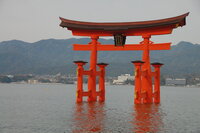
On a rather brighter note, a day trip out of Hiroshima (local train and ferry) took us to the enormously touristy and marginally tacky little island of Itsukushima. This place is considered one of the top attractions in Japan and one of the top three views in the entire country. Hint: it's neither!
Sometime in the 1500s, some bright-spark had the idea to construct a Torri in the sea. Apparently, one had to approach the island by passing through the gate. Remarkably (or not), rather like the Ship of Theseus, the Torri is still standing to this day and is responsible for the massive influx of visitors on a daily basis. We organised our visit to coincide with a pretty high tide as the sight is not quite so impressive with the Torri standing in fishy mud! It was an interesting sight and rather unusual, but it's not big and it's not very far from the beach. Put all that together with its reputation and you get a somewhat underwhelming experience. Still, tick in a box and all that.
The visit to see the Torri took about 15s, so we also took the cable car up a local mountain and hiked the last half hour to the summit for some excellent views of what's known as "The Inland Sea", but which is really just the sea. At the summit, we bought an ice-cream from a vending machine and then walked the 1500' back down again. The 360° views at the summit were excellent (the ice-cream was not).
Finally
We were only in Hiroshima and its environs for a couple of days, so there's not much more to report and the end of our trip is looming large. We have a Shinkansen-based race across half the length of Honshu, which is the big island. That should take about five hours to deliver us back to Tokyo where we'll spend a couple of days using up the last of our currency and looking forward to serving 15 hours at the pleasure of Boeing.
Some Pictures
